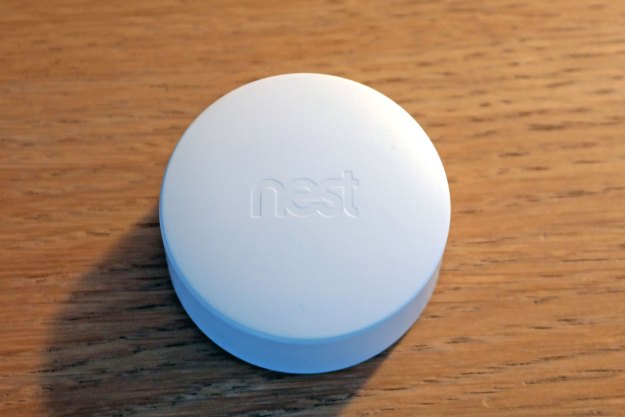
“The cute and compact Nest Temperature Sensor will put an end to those hot and cold spots in your home”
- Compact, well-built hardware
- Simple installation
- Easy configuration
- Works well to combat hot and cold spots around the home
- No customization options for timing schedule
- No motion detection
In the smart thermostat arena, two products in particular have been battling for supremacy. In the blue corner, the Nest Learning Thermostat and budget Nest E variant combine simplicity and beauty with an iconic design that’s won hearts and minds around the globe.
In the red (make that green) corner, Canada’s ecobee, now in its fourth generation, has quickly positioned itself as a capable challenger sporting advanced features such as far-field voice recognition plus integrations with Amazon Alexa, Apple HomeKit and Google Assistant.
Until now, the one major advantage of ecobee was support for remote room sensors, which could read temperatures around the house (not just where the thermostat was installed), working to reduce hot or cold spots. Embroiled in corporate turmoil, it’s an obvious feature to which Nest Labs have been slow to respond. Until now.
Alongside recent headline-grabbing product launches such as the Nest Hello smart doorbell, Nest Secure alarm and much-delayed Nest x Yale smart lock, the $39 Nest Temperature Sensor ($99 for a three-pack) is a basic, but potentially invaluable accessory from a company that’s most definitely rediscovered its mojo.
Hot on top, chilly on the bottom
Living in a four-floor home with a poorly-positioned, first-floor thermostat, I’m the perfect customer for Nest Temperature Sensor. Having installed a third-generation Nest Learning Thermostat a couple of years back, I’ve been delighted with how the devices blends into the home and how easy it is to control via the device itself, either though the Nest app or Google Home. But the Nest has been unable to balance the temperature of various rooms around the home.
While the family room, where the thermostat is located, remains cool in the summer and toasty in the cold Canadian winters, the opposite is true of the attic, where my office is located. I’ll admit, I was ready to jump over to ecobee – but could the Nest Temperature Sensor save the day?
Compact, high-quality design and build
Nest is no stranger to sensor development. As we mentioned in our Nest Secure review, the company’s engineers and designers are adept in developing compact sensors that are both smart and sexy. The design of the circular Nest Temperature Sensor mimics the shape of the company’s Learning Thermostat but is intended to be mostly invisible.
Nest’s engineers and designers are adept in developing compact sensors that are both smart and sexy.
That said, the device is clad in soft-touch, matte plastics that look good and feel super solid. Rubberized backing protects your walls from marks when installed or serves as a grip for flat surfaces, while even the rear battery door is styled with circular etching and a matte notch. We expect a high standard of finish from $300 Nest devices, but it’s also pleasing to see it applied to the brand’s cheaper items.
Unlike those high-end products, the Nest Temperature Sensor is simply packaged, with a self-tapping mounting screw as its only accessory. We were surprised to notice the omission of a wall anchor, given that these are a regular inclusion in most Nest packages, so you may want to add your own when installing the device.
How does it work?
While Nest sells the Temperature Sensor in single or three packs, up to six sensors can be connected to a single thermostat. Once connected (via Bluetooth LE, meaning they keep working even if your Wi-Fi drops), sensors report local temperatures to your thermostat. Bear in mind that room sensors are no substitute for a multi-zone heating system, so they won’t help deliver different temperatures in different rooms.
If you have multiple sensors around the home, you can select one to control the thermostat or schedule the thermostat to respond to different sensors throughout the day. That allows you to ensure rooms are comfortable when they’re most likely in use. While it would have been great to see Nest add motion detection in the Temperature Sensor (like Nest Detect) sadly, that’s not the case in this first-generation accessory.
Powered by a CR2 battery, Nest says that you should expect up to two years of operation before you’ll need to swap it out. That’s aided by the sensor’s Bluetooth Low Energy connectivity, but on the flipside, the relatively short range of that technology means that sensors will need to be positioned within 50 feet of your thermostat. That said, we had no issues connecting a sensor two floors up from the thermostat, and you can check the connection at any time from the Nest app.
Easy installation and temperature management
A flawless installation procedure connects the sensors to your thermostat using the Nest app. To identify the sensors, you simply scan a QR code, printed on the inside of the battery cover. Designate the room in which the sensor will be installed, and the app takes care of the rest.
It’s pleasing to see a high standard of finish applied to the brand’s cheaper lines.
We were then prompted to create a schedule for temperature control, but were disappointed that we were forced to adopt preset Morning (7-11 a.m.) Midday (11 a.m. to 4 p.m.) Evening (4 p.m. to 9 p.m.) and Night (9 p.m. to 7 a.m.) time slots, selected by Nest’s developers. A first-world problem, maybe, but those slots didn’t quite line up with our daily movements around the house, and there’s no option to tweak.
Once configured, however, we found the sensors were effective in making the rooms at the top and bottom of the house to be more comfortable. The attic office, usually chilly on a spring morning, no longer required an extra layer for warmth, while the basement remained cool enough in the evenings for a workout.
One knock-on effect is that we found the family room, where our Nest thermostat is located, did get a little too warm in the afternoon when priority was handed to the attic sensor. So, it may take a few days of temperature tweaking to achieve the right balance at home. These sensors are clever, but as mentioned before, they’re no substitute for a multi-zone heating system.
Warranty information
Nest Temperature Sensors are supported by a one-year limited warranty.
Our Take
It may not be necessary for all, but for larger, single-zone homes with the Nest Learning Thermostat, the Nest Temperature Sensor is an invaluable accessory from a company that’s most definitely rediscovered its mojo.
Is there a better alternative?
The Nest Learning Thermostat doesn’t support third-party temperature sensors, so unless you want to switch to ecobee ($249 for the thermostat, with an additional sensor included), this is the accessory you need.
How long will it last?
These temperature sensors should be considered a set-and-forget purchase and, unless any stability issues are encountered, they shouldn’t need to be updated. With Nest Labs now firmly back in parent-company Google’s fold, we don’t anticipate issues with any long-term support.
Should you buy it?
If you experience hot or colds spots around the home with the Nest Learning Thermostat, you should add one or more Nest Temperature Sensors to your setup.
Editors' Recommendations
- Should you buy a new smart lock or retrofit your existing deadbolt?
- Best vacuum deals: Cordless to corded, Dyson to Bissell
- Best air conditioner deals: Portable and window units on sale
- Matter gains support for kitchen appliances, adds new energy-tracking features
- The 5 best office chairs for long hours in 2024












